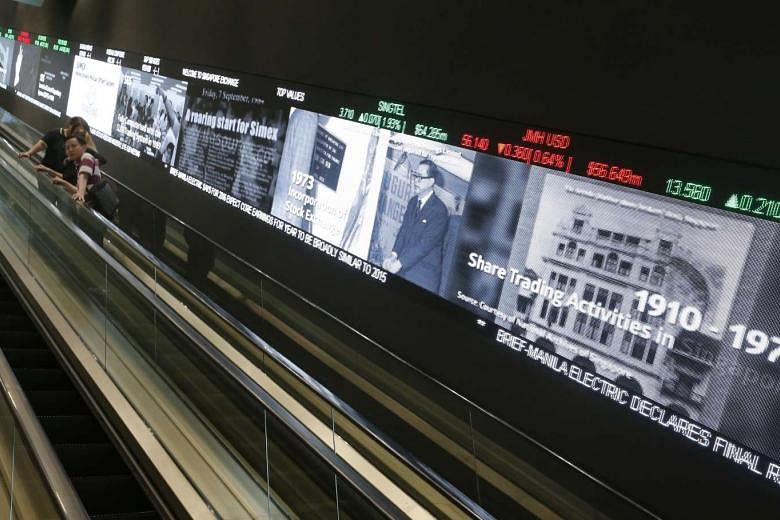SINGAPORE - Technology stocks have literally fallen off a cliff.
The FTSE ST Technology Index, which tracks 46 tech stocks, had plunged 41.4 per cent in the past 12 months, far outstripping the loss of the benchmark Straits Times Index which was down 15.5 per cent over the same period.
That tech stocks should be flashing red in the stock market is a stark reflection of the on-going slow-down in the broader manufacturing sector which registered a 5.2 per cent contraction last year.
And it does not appear that the outlook will brighten any time soon, with a survey of purchasing managers showing that factory activity has sunk to its lowest level in three years.
Thus, despite the valiant efforts by analysts extolling the virtues of these beaten down stock market darlings to investors, it is difficult to stir up investors' interest in them.
Take plastic products manufacturer Fu Yu Corp which traded to as high as 99.2 cents apiece during its hey-day 12 years ago which valued the company at a cool $747 million.
Now, it trades at only a fraction of that price, 19.5 cents, as its market capitalisation tumbled to just $146.8 million - resulting in a staggering loss of $600.5 million over the period.
Yet, as RHB Securities analyst Jarick Seet observed in a recent report, Fu Yu is a "safe haven full of cash with strong cash-flow generation and high dividend yields".
It should be a "no-brainer" investment in the current tough market conditions, he added.
And despite efforts by its management to reach out to investors at road-shows, and talk of using its cash-pile to do share buybacks, the company still trades a tad below the minimum trading price requirement of 20 cents imposed by the Singapore Exchange.
Yet, investors can't be blamed for their lack of risk appetite for tech stocks - many of which are contract manufacturers which make products for other companies.
In the past decade, the manufacturing landscape has changed beyond recognition on a global scale.
This has put the squeeze on the profit margins of local contract manufacturers, even for those which had the foresight to relocate their factories to countries where production costs are much lower.
Worse, some contract manufacturers have to contend with new technologies which threaten to obliterate their existence overnight.
Such risks make them unsuitable for the buy-and-hold mum-and-dad investors whose only objective is to achieve a better-than-average return on their hard-earned savings.
One example is electronic component maker Memtech International. Listed in 2004, it used to get the bulk of its business from supplying keypads to mobile phone makers such as Nokia, Motorola and Sony Ericsson. It also made all the right moves, like having its production facilities in low-cost cities such as Dongguan and Nantong in China.
But as its executive chairman Chuang Wen Fu recounted in a recent interview in SGX Gateway, the company almost faced extinction in 2011 when touch-screens started to replace keypads in a big way, as the smartphone revolution gained momentum.
"Keypads virtually disappeared overnight, and revenues collapsed. Those were my darkest moments. I wasn't sure we would survive," he said.
Mr Chuang had anticipated that with the growing popularity of smartphones, the use of keypads in handphones would only be discontinued within two years. But the change-over took a mere 10 months and gave Memtech precious little time to look for an alternative viable business to diversify into.
More invidious is the challenge posed by foreign contract manufacturers which enjoy huge economies of scale because of their vast operations as well as the flexibility they have in being able to deploy their hardworking and dependable workforce.
Foxconn, the world's largest contract manufacturer, is said to have over one million workers - more than twice the number of all the people employed in the manufacturing sector in Singapore.
It has also taken techniques learnt from the Japanese like "just in time" manufacturing to a fine art.
A former Apple executive recounted in the New York Times that just weeks before the first iPhone was due to hit the shelves eight years ago, the company redesigned the smartphone's screen at the last minute, causing an assembly overhaul in the China factory which made the phones.
"A foreman immediately roused 8,000 workers inside the company's dormitories. Each employee was given a biscuit and a cup of tea, guided to a workstation and within half an hour, started a 12-hour shift fitting glass screens into bevelled frames. Within 96 hours, the plant was producing over 10,000 iPhones a day," he said.
It is a feat which no US factory - or for that matter, local contract manufacturers - would be able to match.
Contract manufacturers here hope that new technologies such as 3D printing and digital manufacturing will help to re-invigorate their operations and restore their competitive edge. But the problem is that the foreign rivals, which had beaten them before, are also looking to use the same technologies to stay ahead of the game.
One entrepreneur complained that the SGX is known for supporting dividend-based companies and seafood restaurants such as Jumbo Group, rather than companies which would support innovation and a strong manufacturing environment.
But the SGX may be behaving in this manner because it is responding to the change in investors' appetite here. Unlike years ago when tech stocks were snapped up like hot cakes, investors are giving them a wide berth now - and for good reasons.


